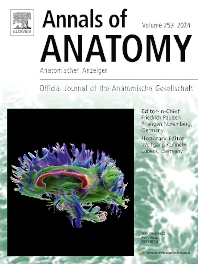Journals in Anatomy
Journals in Anatomy
Annals of Anatomy
Anatomischer AnzeigerAnnals of Anatomy publish peer reviewed original articles as well as brief review articles. The journal is open to original papers covering a link between anatomy and areas such as• molecular biology, • cell biology • reproductive biology • immunobiology • developmental biology, neurobiology • embryology as well as • neuroanatomy • neuroimmunology • clinical anatomy • comparative anatomy • modern imaging techniques • evolution, and especially also • agingMoreover, manuscripts dealing with all forms of anatomical teaching and new forms of curricula will be considered for publication. Priority will be given to experimental studies; merely descriptive studies will only be published if the Editors consider that they are of functional significance.For more than a century the Annals of Anatomy have been one of the most famous and widespread journals on morphology. The journal is the official journal of the Anatomische Gesellschaft (Anatomical Society).- ISSN: 0940-9602

Neuromodulation: Technology at the Neural Interface
Neuromodulation: Technology at the Neural Interface is the preeminent journal in the area of neuromodulation, providing our readership with state of the art clinical, translational, and basic science research in the field. For clinicians, engineers, scientists, and members of the medical device industry alike, Neuromodulation provides timely and rigorously peer-reviewed articles on the technology, science, and clinical application of devices that interface with the nervous system to treat disease, alleviate symptoms, and improve function. Representing the needs of the broad neuromodulation community, the journal serves as an instrument for exchanging high-quality data, advancing science, and as a forum for debate and commentary. Neuromodulation covers an ever-expanding field including pain, headache, movement disorders, spasticity, paralysis, psychiatric and cognitive disorders, epilepsy, sensory deprivation, cardiovascular, gastrointestinal, and genitourinary disorders among others. As the official journal of the International Neuromodulation Society (INS), it represents the international practice of neuromodulation, a growing, diverse multidisciplinary field responsible for the development and application of both invasive and non-invasive devices and techniques to benefit individuals by normalizing or augmenting function and reducing the impact of disease. In-depth reviews, original articles, national and international meeting abstracts, special focus editions, and web-based and social media educational offerings help the reader to expand their knowledge and understanding of the interface between electrical stimulation, chemical neuromodulation and the nervous system. Our updates on past and future news of events and activities of the INS and its membership keep the reader abreast of issues related to professional education and development in this dynamic field.- ISSN: 1094-7159
